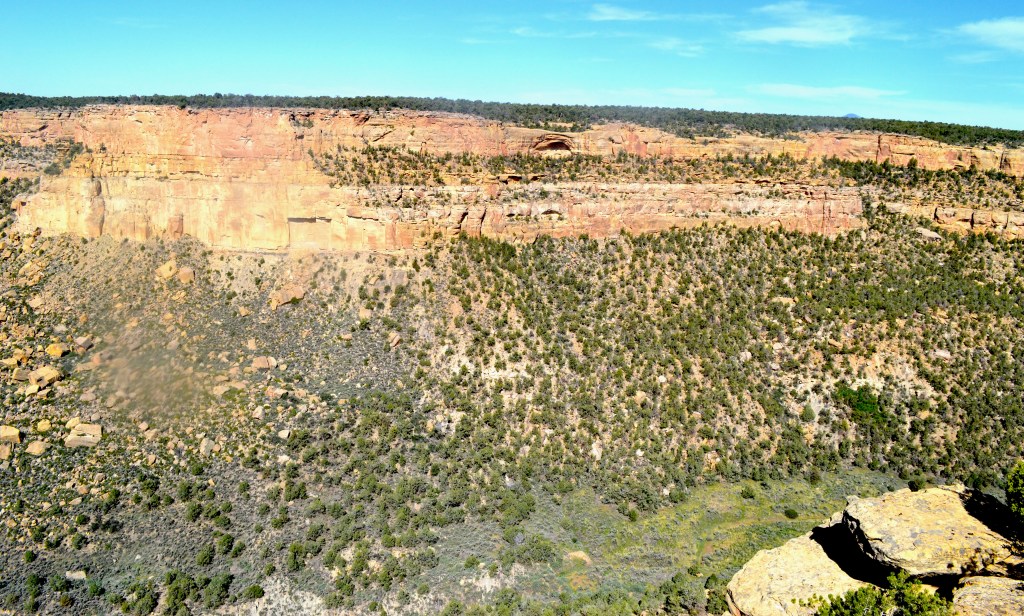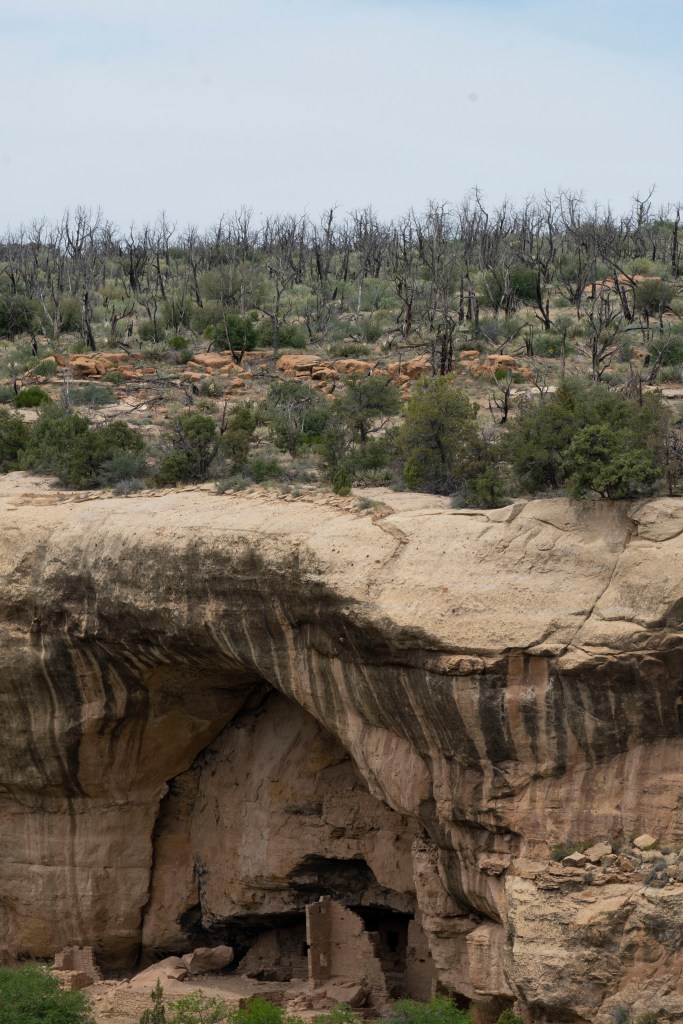Mesa Verde, located in Colorado, is a gathering of architectural and geological wonders.
TABLE OF CONTENTS
- Geological Past
- First Peoples
- Agriculture
- First Europeans at Mesa Verde
- Pre & Post National Park
- Future
- Learn More!
Geological Past

Mesa Verde was located in the Western Interior Seaway (WIS), which stretched from Canada to the Gulf of Mexico.
The WIS receded and expanded, depositing minerals which settled into sediment layers, building the cliffs that eventually led to the dwellings of the Ancient Puebloans. Mesa Verde is a result of this phenomenon.
Today, Mesa Verde is located on the Colorado Plateau in the Southwestern United States in a region known as the Four Corners, where the states of Colorado, New Mexico, Utah, and Arizona meet.

Map of the Four Corners- courtesy of Wikipedia
Mesa Verde is Spanish for “green table”. Mesa Verde, ironically, isn’t a true mesa but a “cuesta”, as its slopes gently dip in one direction.
The gently-dipping slopes provide alcoves, or arched recessions in cliff walls, in which Ancestral Puebloans settled. These alcoves provided protection from the elements, while the insulation made residences cool in summer and warm in winter. Mesa Verde is continually being carved by the water flowing through it.

Dark-colored streaks are found on the walls throughout Mesa Verde, often at spots where water is run off. These streaks are desert varnish, formed when manganese is fixed to cliff faces by bacteria.
First Peoples
The original inhabitants of Mesa Verde were the Ancestral Puebloans, long known by the Navajo (Dine) derogatory term for them “Anasazi”. They lived in the northern American Southwest from the beginnings of agriculture until the arrival of the Spanish in 1540 A.D. Shared cultural traits included pottery, kivas (subterranean ceremonial chambers), and, of course, pueblos (multi-room structures).
In the western Southwest, Puebloans were dry/floodwater farmers whose religious beliefs revolved around rain. In the eastern Southwest, Puebloans practiced dry/floodwater farming and small-scale irrigation agriculture. Religion wasn’t as rain-centric.



Mesa Verdeans originally didn’t live in alcove pueblos, but on top of the cuesta. Only circa the late 1190s A.D. did they move into the alcoves, and even then agriculture remained atop the cuesta (it received the most direct rainfall).
In the late 1270s A.D., the inhabitants of Mesa Verde migrated to what are today Arizona and New Mexico. By 1300 A.D., Ancestral Puebloans disappeared from Mesa Verde. Their reasons for leaving are debated (drought, resource depletion, social upheaval) to this day.
Ancestral Puebloans are, indeed, the ancestors of modern Puebloan peoples, though lineages can range from direct to indirect to a mixture of the two. This is partially explained by population shuffling after 1300 A.D., which resulted in Puebloan groups mingling with each other more often. The Hopi, for instance, derive their ancestry from the Kayenta, Little Colorado, Mesa Verde, and potentially Chaco, peoples.






There is more vegetation in Mesa Verde area than you’d expect from a desert; no wonder Spanish colonizers referred to it as “Green Table” / Image Credit: Own Work
Mesa Verde contains oaks, snowberry, yucca, Oregon grape, and other plants. From lowest to highest, the vegetation divisions are the shrub-steppe, pinyon-juniper woodland, mountain shrub system, and Douglas fir/Ponderosa pine woodland. The plants, and limited water sources, provide sustenance for wildlife such as mule deer, which provide sustenance for predatory creatures such as coyotes.
Agriculture

Mule Deer- courtesy of the Mesa Verde National Park Service
North American agriculture’s beginning is believed to be circa 7000 B.C. – 4250 B.C. in Mexico. The Colorado Plateau, where Mesa Verde is located, contains domesticated corn and squash evidence circa 1000 to 2000 B.C. In Mesa Verde itself, the earliest agricultural evidence is from 400 B.C.
Mesa Verdean land wasn’t, and isn’t, suited to irrigation and other flood-based farming. Rather, inhabitants used, and still use, precipitation-based farming. Crops are grown atop mesas so as to receive the most direct rainfall. However, rainfall on its own isn’t always enough, given the dry climate. Cisterns and reservoirs are also used.
First Europeans at Mesa Verde
In 1765, New Mexico governor Tomas Velez Cachupin ordered Don Juan Maria de Rivera to embark on a northwesterly expedition. These explorers mentioned indigenous ruins, though it’s unclear if they’d specifically seen those of Mesa Verde. In 1859, the first confirmed instance of a European seeing Mesa Verde was geologist Dr. John S. Newberry.
Pre & Post National Park
In 1874, photographer William Henry Jackson teamed up with miner John Moss on a journey to the cuesta’s ruins. The photographs taken renewed interest in Mesa Verde. It wasn’t until 1886, however, when the land was proposed to be a national park.
In 1905 (following several abortive bill passings), a bill for the creation of Mesa Verde National Park was introduced in Congress. Under President Theodore Roosevelt, the bill was passed and the park itself was created on June 29, 1906.
In 1978, Mesa Verde National Park was declared a UNESCO World Heritage Cultural Site.
In 2006, Mesa Verde National Park’s 100th anniversary was commemorated. Native American remains and goods buried with them were moved to an undisclosed part of the park by the Hopi and the park staff.
Future
Mesa Verde is a landmark which offers plenty in terms of food growth potential, human history, and natural history. Research derived from it in the future can assist fields such as Southwestern American agriculture, histories of Native Americans, and geological endeavors.
Learn More!

by David E. Stuart
by Duane A. Smith — https://www.amazon.com/Mesa-Verde-National-Images-America/dp/0738569461/ref=asc_df_0738569461/?tag=hyprod-20&linkCode=df0&hvadid=343276534991&hvpos=&hvnetw=g&hvrand=2039299698917945954&hvpone=&hvptwo=&hvqmt=&hvdev=c&hvdvcmdl=&hvlocint=&hvlocphy=9001878&hvtargid=pla-809602694844&psc=1&tag=&ref=&adgrpid=66484626702&hvpone=&hvptwo=&hvadid=343276534991&hvpos=&hvnetw=g&hvrand=2039299698917945954&hvqmt=&hvdev=c&hvdvcmdl=&hvlocint=&hvlocphy=9001878&hvtargid=pla-809602694844

https://www.mesaverde.org/ancient-ruins-rock-art-sw

https://www.mesaverde.org/cliff-dwellers-mesa-verde
Sources:
- “Mesa Verde”. United States National Park Service. September 3, 2015 (Updated). https://www.nps.gov/meve/learn/historyculture/index.htm
- “The Geology of Mesa Verde”. United States National Park Service. March 5, 2021 (Updated).
- “Ancestral Puebloan”. United States National Park Service. December 7, 2015 (Updated). https://www.nps.gov/subjects/swscience/ancestral-puebloan.htm
- “Stepping Back in Time”. Visit Mesa Verde. https://www.visitmesaverde.com/discover/park-history/#:~:text=On%20June%2029%2C%201906%2C%20President,research%20and%20resource%20management%20staff.
- “Important Events in the Development and Preservation of Mesa Verde National Park”. United States National Park Service. August 8, 2020 (Updated). https://www.nps.gov/meve/learn/historyculture/stories.htm#:~:text=By%201859%2C%20several%20groups%20had,1859%20San%20Juan%20Exploring%20Expedition.
- “Ecology of Mesa Verde National Park”. USGS. https://www.usgs.gov/geology-and-ecology-of-national-parks/ecology-mesa-verde-national-park
- “The Beginnings of Agriculture”. Crow Canyon. 2011 (Original), 2014 (Updated). https://www.crowcanyon.org/EducationProducts/peoples_mesa_verde/archaic_agriculture_begins.asp
- Simon, Rebecca. “Preparing for the Future While Studying the Past: Ancestral Pueblo Farming”. Project Archaeology. November 20, 2015. https://projectarchaeology.org/2015/11/20/preparing-for-the-future-while-studying-the-past-ancestral-pueblo-farming/
ancient publeon Casa Riconda Chacoan Great Houses Chaco Culture National Historical Park cliff palace Hugo Pavi isla mujeres Junior Park Ranger program Kivas long house mesa verde Mesa Verde audio tour mug house National Park North Beach petroglyphs Petroglyph trail Pueblo Bonito Pueblo del Arroyo Recreation.gov reviews Square House Tower Supernova tour ultramar Una Vida Wetherill mesa whale shark snorkel
